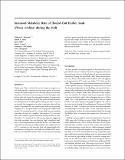Files in this item
Increased metabolic rate of hauled-out harbor seals (Phoca vitulina) during the molt
Item metadata
| dc.contributor.author | Paterson, William D. | |
| dc.contributor.author | Moss, Simon E. | |
| dc.contributor.author | Milne, Ryan | |
| dc.contributor.author | Currie, John I. | |
| dc.contributor.author | McCafferty, Dominic J. | |
| dc.contributor.author | Thompson, Dave | |
| dc.date.accessioned | 2022-03-12T00:44:35Z | |
| dc.date.available | 2022-03-12T00:44:35Z | |
| dc.date.issued | 2021-05-01 | |
| dc.identifier | 273830974 | |
| dc.identifier | c1dd6cee-fb99-460c-8e04-db9a7c6d6b88 | |
| dc.identifier | 000627929800001 | |
| dc.identifier | 85102911870 | |
| dc.identifier.citation | Paterson , W D , Moss , S E , Milne , R , Currie , J I , McCafferty , D J & Thompson , D 2021 , ' Increased metabolic rate of hauled-out harbor seals ( Phoca vitulina ) during the molt ' , Physiological and Biochemical Zoology , vol. 94 , no. 3 , pp. 152-161 . https://doi.org/10.1086/713958 | en |
| dc.identifier.issn | 1522-2152 | |
| dc.identifier.other | ORCID: /0000-0003-1546-2876/work/92371839 | |
| dc.identifier.uri | https://hdl.handle.net/10023/25035 | |
| dc.description.abstract | Harbor seals (Phoca vitulina) live in cold temperate or polar seas and molt annually, renewing their fur over a period of approximately 4 wk. Epidermal processes at this time require a warm skin; therefore, to avoid an excessive energy cost at sea during the molt, harbor seals and many other pinnipeds increase the proportion of time they are hauled out on land. We predicted that metabolic rate during haul-out would be greater during the molt to sustain an elevated skin temperature in order to optimize skin and hair growth. To examine this, we measured post-haul-out oxygen consumption (V˙O2) in captive harbor seals during molt and postmolt periods. We recorded greater V˙O2 of seals while they were molting than when the molt was complete. Post-haul-out V˙O2 increased faster and reached a greater maximum during the first 40 min. Thereafter, V˙O2 decreased but still remained greater, suggesting that while metabolic rate was relatively high throughout haul-outs, it was most pronounced in the first 40 min. Air temperature, estimated heat increment of feeding, and mass also explained 15.5% of V˙O2 variation over 180 min after haul-out, suggesting that the environment, feeding state, and body size influenced the metabolic rate of individual animals. These results show that molting seals have greater metabolic rates when hauled out, especially during the early stages of the haul-out period. As a consequence, human disturbance that changes the haul-out behavior of molting seals will increase their energy costs and potentially extend the duration of the molt. | |
| dc.format.extent | 10 | |
| dc.format.extent | 1841054 | |
| dc.language.iso | eng | |
| dc.relation.ispartof | Physiological and Biochemical Zoology | en |
| dc.subject | Phoca vitulina | en |
| dc.subject | Harbor seal | en |
| dc.subject | Marine mammals | en |
| dc.subject | Pinnipeds | en |
| dc.subject | Metabolic rate | en |
| dc.subject | Haul-out | en |
| dc.subject | Molt | en |
| dc.subject | QH301 Biology | en |
| dc.subject | NDAS | en |
| dc.subject | SDG 14 - Life Below Water | en |
| dc.subject.lcc | QH301 | en |
| dc.title | Increased metabolic rate of hauled-out harbor seals (Phoca vitulina) during the molt | en |
| dc.type | Journal article | en |
| dc.contributor.institution | University of St Andrews. School of Biology | en |
| dc.contributor.institution | University of St Andrews. Sea Mammal Research Unit | en |
| dc.contributor.institution | University of St Andrews. Scottish Oceans Institute | en |
| dc.contributor.institution | University of St Andrews. Marine Alliance for Science & Technology Scotland | en |
| dc.identifier.doi | https://doi.org/10.1086/713958 | |
| dc.description.status | Peer reviewed | en |
| dc.date.embargoedUntil | 2022-03-12 | |
| dc.identifier.url | https://eprints.gla.ac.uk/234054/ | en |
This item appears in the following Collection(s)
Items in the St Andrews Research Repository are protected by copyright, with all rights reserved, unless otherwise indicated.

